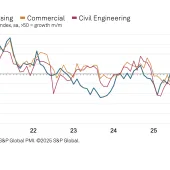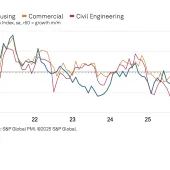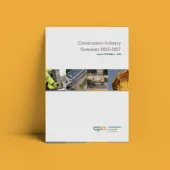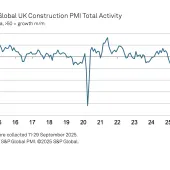The Aggregates Industry - A Way Ahead

By Julian Clapp, chief executive, BDS Marketing Research Ltd
It is only two years since the author last contributed an article to Quarry Management, yet the state of the market has made it seem much longer. The article ‘The Market – Where Now?’ assessed the likely course of aggregates demand following a period of a major decline in volumes in 2009. It correctly predicted that the market would not fall further. However, the recovery in private house building has not been as strong as expected, and therefore the increase in ready-mixed concrete markets has been less than forecast. On the other hand, asphalt demand has performed better than expected, with local authorities spending more money on road resurfacing before the public expenditure cuts. Aggregates markets have been performing much in line with the previous forecast.
The purpose of this article is not to present a detailed update to these forecasts. For the record, the cuts in public expenditure will limit demand for several years. Recovery in the private sector is expected to be sluggish and is unlikely to make up for the decline in the public sector. By the end of 2013, it is expected that most of the cuts will have worked through the system and the private sector should be growing more strongly. In five years’ time BDS Marketing Research Ltd are forecasting aggregates demand at around current levels, with asphalt markets lower by 15% (due to the sector’s reliance on public expenditure) and ready-mixed concrete demand higher by 5%. Although markets are currently improving, they are expected to start to weaken during 2011 as the cuts take hold.
The timing and extent of trends can be debated. However, the question for aggregates and ready-mixed concrete companies is how to improve performance in a market that is unlikely to grow in the medium term. This article attempts to provide some answers to this question for both large and small companies.
When BDS started in 1989 there were around 15 major regional and national companies. There are now just five national players – soon to be become four – and two significant regional companies. At the same time of expansion, these national businesses were selling off non-core assets. More recently, companies have been closing or selling individual sites in response to the recession. In most cases, a majority of the output from closed operations could be met by the same company from neighbouring sites. However, remaining operations are now spread more thinly, and analysis of the market shows that further closures could result in companies being unable to supply from other units as these are too far away, for both economic and practical considerations. Any future closures will, therefore, have more impact on the company concerned than previously.
The major companies have implemented the correct strategy of acquiring businesses, developing downstream and upstream activities and selling peripheral sites. Overheads have been cut and management structures changed. Acquisition of units that have to be sold for the proposed Tarmac and Lafarge joint venture to proceed, will provide a short-term boost for other companies. However, it is difficult to see how continuation of the current strategy is going to improve performance in the medium and long term. Costs have already been cut, the potential for other acquisitions is limited and the market is unlikely to provide salvation.
In the author’s view, a possible solution is for the major companies to consider investment in alternative markets. Such markets today are unlikely to provide much – if any – synergy with existing aggregates markets. Previous expansion into closely related markets, including concrete products, proved only a mixed success. An ideal solution would be to find a market that is in a similar situation to the quarrying industry in the 1950s. At this time there were opportunities for both market growth and development through acquisition. Diversification now would provide opportunities for growth which existing markets do not. Two areas perhaps worthy of further study are renewable energy and sustainability.
This recommendation goes against all the reasoning and strategy that the industry has adopted over several decades. It will be difficult to convince companies that this is the right course. However, existing strategies are unlikely to generate good returns in the foreseeable future, and maybe now is the time to find an alternative. Strategy needs to be consistent but also flexible enough to move with events. The most successful companies tend to be those that best predict the future – and respond – before others follow.
Smaller companies have sufficient potential without the need to consider such a change of direction. Here, the strategy should be to maintain good reserves and ensure a spread of operations across added-value markets. These companies need flexibility to cater for, and respond to, local markets. There are also some possible development opportunities in growth markets such as interlocking wall blocks and twin-wall products.
One area that offers both a threat and an opportunity for all companies is the increasing scarcity of aggregates in local markets. This is due to the difficulty of obtaining new reserves. In only one year since 1990 has the industry more than replenished the amount of aggregates it has extracted. This problem was identified 35 years ago in the Verney Report, ‘The Way Ahead’. Although supply has not changed as expected, the situation is now getting worse. This is not suddenly going to affect large parts of the country, but, over a period of time, shortages will occur. In an area of shortage, not all companies will exhaust reserves at the same time, and those that run out first will be at a disadvantage. They have the option of either purchasing from competitors or bringing in their own aggregates from elsewhere, but at a higher cost. This is already occurring.
One aggregates company has run out of sand and gravel in an area and is now having to import crushed rock by rail to supply its concrete plants. The largest sand and gravel company locally has plentiful supplies; so plentiful, in fact, that it is able to transport material to another market area where it does not have sand and gravel. Ironically, the first company that ran out of reserves has sand and gravel in this other market area. There would be no loss of contribution if the two companies bought from each other in the market where they have reserves. This is an example of ‘localism’ that would work for the industry. There would be a saving in haulage costs of more than six figures, as well as an environmental benefit. As companies are increasingly faced with these situations, there is a need for local co-operation in sourcing aggregates, development of rail depots etc. Alternatively, companies that run out of concreting aggregates in an area may decide to exit the concrete industry in the locality as well.
All companies have, understandably, concentrated on weathering the recession, but they also need to understand the trends that are affecting the business. During the recession there has been growth in companies supplying ready-mixed concrete markets in volumetric trucks. Research undertaken by BDS has identified 200 companies in this sector, operating around 550 vehicles. The sector as a whole now represents an estimated 8.5% of the concrete market. Within three years it is likely that only three ready-mixed concrete companies will supply more concrete than the volumetric sector put together. Only a handful of batched concrete companies have entered this field. Just a decade ago, the first truckmixer to be seen in the morning was likely to be operated by a national company. Today, there is a good chance that same load of concrete will be delivered in a volumetric lorry. To ensure that further market erosion does not occur, concrete companies need to consider entering the volumetric sector or changing the way that this market is currently serviced, or both.
The same sort of thing is happening in aggregates. There is a growth in small companies offering a ‘one-stop shop’ of products from a single location. These products will include the full range of aggregates, decorative aggregates and packed products. Companies operate in a similar way to builders’ merchants but concentrate on aggregates and a limited range of other heavy building materials, such as packed cement. These products are stocked for collection or the supplier may use smaller vehicles to deliver them. There is little doubt that customers will pay more for a small load if it is available locally and can be delivered in a small vehicle for ease of access, or collected from a site without queuing.
All products have to be double handled by independent merchants and it seems, in the author’s opinion, that aggregates companies should be in a better position to supply. A merchanting-type operation could be based at an existing quarry, thereby eliminating the need to double handle all products. Aggregates not available at the quarry could be backhauled from other company sites, as required. The keys to success include location close to a population centre, availability of a range of transport, and suitable access at the quarry to handle collected sales. One option could be to site such an operation at a quarry that has closed recently.
When markets were nearly twice current levels, the industry did not have to concern itself too much with the small-loads market, but times have changed. There does appear to be a gap in the market between general builders’ merchants that stock a limited range and aggregates companies that concentrate on full loads to the major end-users. This sector is likely to grow as supplies of local aggregates are exhausted and more materials are imported from other extraction areas.
Some aggregates companies are already likely to have sites where higher-margin collect materials represent an important contribution. These may have natural historical advantages of location and supply source. However, whether this is due to a concerted marketing campaign offering a wider range of materials than those at the quarry, is open to debate. The author knows of no sites operated by any aggregates company that are specifically geared towards the small-loads and collect market, yet there could be 100 such sites operated by other companies.
For a major aggregates company, the way forward would appear to be to trial such an operation at an existing site before rolling it out later at other sites. An alternative would be to acquire an existing business.
In conclusion, if companies maintain their current strategy the industry faces several years of little growth in turnover or profitability. Yet there are some exciting opportunities for those companies that understand how the market is changing and are willing to change with it.








